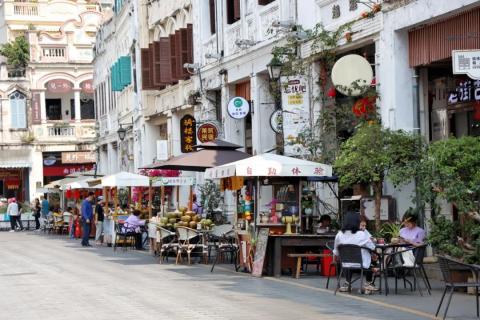Arcade Street, a cultural heritage hotspot in Haikou, retains its unique characteristics accumulated over time
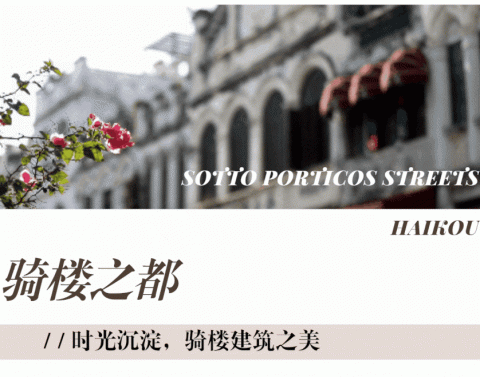
The building complex of Haikou Arcade Old Street was initially formed in the 1920s and 1930s. During its long history, a large number of historical and cultural features have been accumulated, rich in diversity and culture.
There are more than 600 existing arcades, which are the largest and most well-preserved buildings in China of southern style.
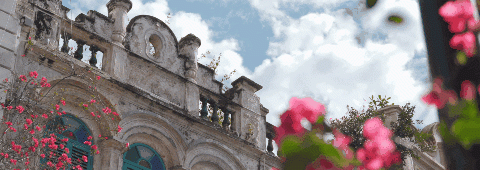
Under the collision of "European architecture" and Chinese "traditional culture," the arcade building complex integrates southern style, Eurasian characteristics and northern Hainan influences.
The areas weaves together history and modern culture perfectly. It is not only the epitome of the changes experienced in Haikou city, but also a destination of history and memories.
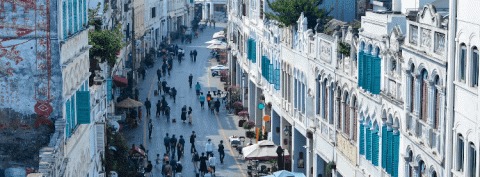
The Slate Road in Arcade Street is of an ancient artistic conception. The residential buildings are scattered and different, and the time-honoured brands are full of brilliance.
From the clear morning light through the carved window lattices, to the human life against the melting moon, beauty and prosperity forms the background of the Arcade Street complex.
This place is buzzing, full of enthusiasm for life. Clean and full of leisure opportunities, the lively streets are fun and interesting!
Among the unique arcade buildings, there is an inconspicuous ancient archway called Haikou Tianhou Palace.
As an important part of Chinese Mazu culture, Tianhou Palace carries the inseparable context of the old city of Haikou.
It is a traditional beam-lifting structure in southern China, magnificent and antique. Thirty-three inscriptions in the courtyard show the historical context of the Hainan Maritime Silk Road.
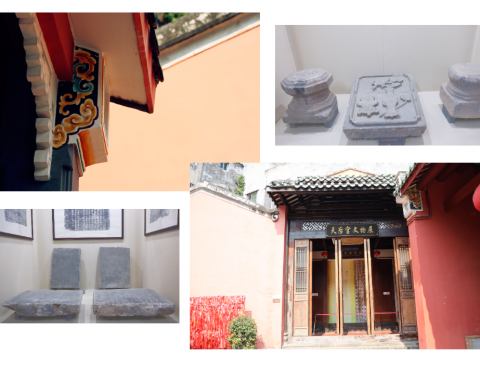
In the ancient documents and folklore of Hainan, there are a lot of materials about Mrs. Xian's development of Hainan, running schools and teaching, and contributing to the development and progress of Hainan.
After thousands of years of historical influences, the Hainan people admired Mrs. Xian, the ancestor of the Feng family, and gradually formed the Mrs. Xian culture of "loving the country and family, being brave and strong, and helping the poor and needy."
In the arcade, this century-old temple has an indissoluble bond with the name of Deshengsha Road. According to legend, the road was originally a beach in ancient times, and it was called Waisha in those days.
Due to the coastal location of Victory Sand, it was a must for pirates to go ashore and loot in ancient times, and because of the characteristics of the gathering of merchants here, it naturally became the first choice for pirates to plunder?
Legend has it that Huang Kaiguang, the chief soldier of the government at that time, dreamed that Mrs. Xian led soldiers to surrender the night before leading the resistance.
The next day, they won the battle. In order to commemorate the victory of the counter-attack, later generations named this beach Deshengsha, and in 1854 built the Temple of Mrs Xian in Deshengsha.
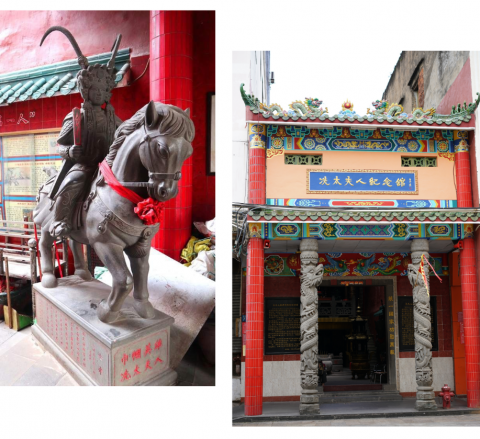
For the imprint imported from the Central Plains culture, the five courtyards of Qiu's house and the exquisite wood carvings tell the glory of the past.
The internal layout of the house is rigorous and has a strong cultural imprint of the Central Plains, especially the wood carving craftsmanship in the house.
The features are very exquisite, including orchids, lotus, jade pendants, ruyi, flower basket, bottle, auspicious clouds, words and so on.
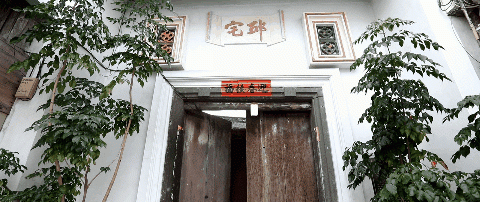

The lower part of the arcade is a shop, and the upper part is a residence-style architectural feature, which combines various architectural styles such as Renaissance, ancient Rome, Baroque, Southern and Chinese tradition.
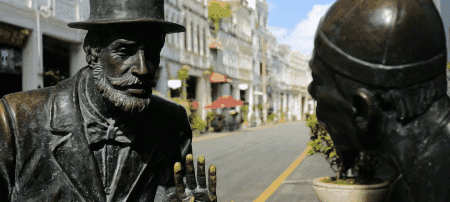
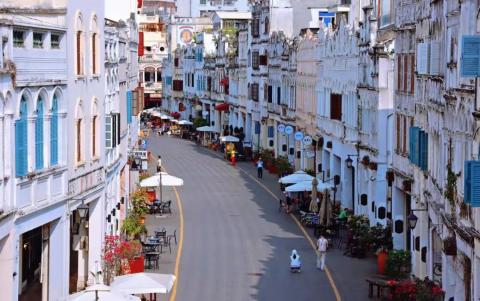
The whole arcade street is like a beautiful curve, drawing out the two worlds inside and outside the old street. The façade of the arcade along the street is divided into three sections: the lower section is the arcade column, the middle section is the floor, and the upper section is the mountain flower and parapet. Usually, the facades of the middle and upper sections of the building are colourfully decorated.
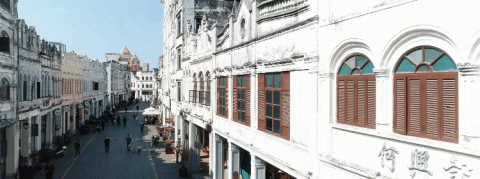
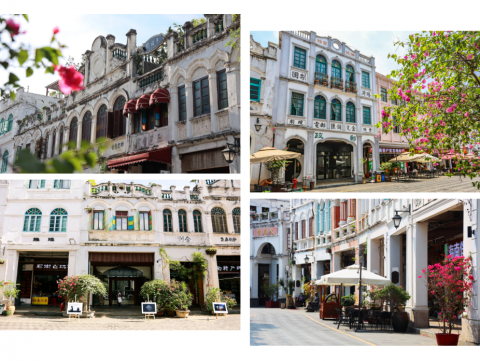
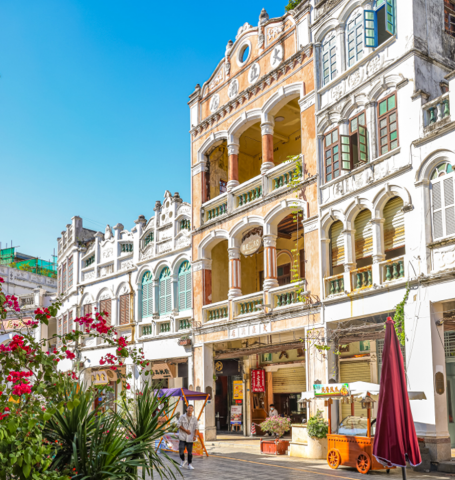
It is said that Haikou is awakened every morning not because the melodious ship chimes at sea, but the bells from the century-old bell tower standing in Haidian Creek.
Every time the mighty sound of the bell tower reverberates in the air, Haikou becomes more vibrant.
The façade shape adopts the corner columns that shrink with the rise of the floor at the four corners to express the three-dimensional sense of the bell tower.
The brick-red clock tower is beautiful and outstanding against the backdrop of green trees, clear water and blue sky.
When you come to Haikou, go to the bell tower to listen to the historic bells.

Huanhai Pavilion, the Arcade Architectural Museum Hotel was formerly known as a century-old commercial firm in Hainan and Guangdong. With the arcade as the carrier for its building characters, the elements of Southern style, the cultural essence of Hainan Island and the historical charm are vividly displayed through architecture.
Here, you can experience the beauty of the space such as the dripping water from the eaves, the light and shadow of the patio, and the four waters returning to the hall.
You can appreciate the beautiful and unique pictures of flowers, birds and animals carved by veteran artists of Hainan grey sculpture, and have a deep understanding of the typical roof forms of folk houses in the north of Hainan.
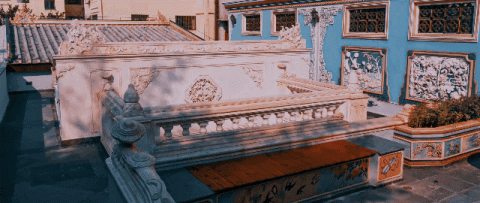
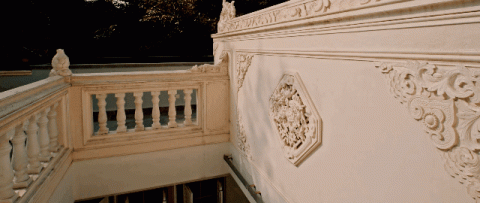
"Shang Nantang, go to Nanyang. Say goodbye to your wife, children, and your parents." Shang Nantang, a three-story teahouse located in the centre of the old arcade street, has the aroma of Zhegu Tea.
Before going to Nanyang, people would stuff two bags of Shangnantang tea in their luggage.
The nursery rhymes that have been sung to this day are the true portrayal of that era's exploration of the South Seas. Today, the time-honored brand "Shangnantang" is re-located on the Old Arcade Street, and has innovated the recipe and craftsmanship of Zhegu Tea, showing the world the natural beauty of pure Shangnantang and authentic Hainan flavour.
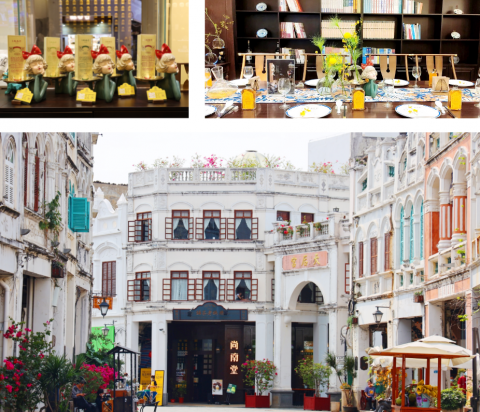
The standard two-entry courtyard of a large family in the North of Hainan not only retains the appearance of the original arcade, but also adds elements of Chinese style.
The Chinese-style carved wooden windows, Chinese-style wooden screens, Chinese-style ceramic ornaments, for example, in Zhongshan Road Zizai Coffee make the whole hall permeate with a strong Chinese style.
Beyond the double wooden doors of the hall, there is a hidden world, a spacious pure Chinese-style courtyard hidden in the bustling Old Arcade Street.
What is unique is that there is a small stage in the courtyard, and there are professional Qiongju performances or a festival every Saturday. The old trees are intertwined, making the backyard lush.

Patios and atriums are often used in arcade buildings. Quanfengtai cleverly uses patios to solve lighting challenges, tackling darkness and humidity.
It was founded in the early days of the Republic of China and has a century-old signature restaurant of the Republic. It is said that "The elegant temperament comes from knowledgeable."
And so are people and architecture. After years past, Quanfengtai, just like a woman kept charm and elegance.

Drink a small cup of tea, sip coffee, and listen to a Qiongju opera in an immersive way; Li nationality double-sided embroidery, sugar painting production, coconut carving...
Take a look at the unique skills of street craftspeople and admire the flat stone road of Haikou's century-old Arcade Street. As if time and space are intertwined, there is still an endless stream of tourists coming and going.

All kinds of small shops, post offices, delicacies... Some of the buildings date back decades and are on the streets in the dim morning light, while others are in the alleys lit by the moon at night. Places that fill empty stomachs and warm lonely hearts.
